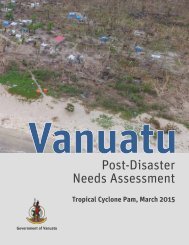Fiji
yqgk302EGjo
yqgk302EGjo
You also want an ePaper? Increase the reach of your titles
YUMPU automatically turns print PDFs into web optimized ePapers that Google loves.
FIJI Post-Disaster Needs Assessment<br />
Table 74: Damage and Losses in the DRM Sector by Division (F$ million)<br />
Division Damage Losses Total Effects Private (%) Public (%)<br />
Central 0.2 2.8 3.0 0.03 99.97<br />
Eastern 0.6 3.5 4.1 0.07 99.93<br />
Northern 0.3 8.7 9.0 0.00 100.00<br />
Western 0.9 12.4 13.3 0.01 99.99<br />
Total 2.0 27.4 29.4 0.02 99.98<br />
Source: Estimations by Assessment Team.<br />
4.4 Performance of the <strong>Fiji</strong> DRM System<br />
Interviews, focus groups and questionnaires with key informants were used to examine the performance of <strong>Fiji</strong>’s overall<br />
DRM system in relation to TC Winston. This section provides insights gleaned from these questionnaires in terms of what<br />
worked well and what areas need strengthening, as well as analysis on the performance of the DRM system undertaken<br />
as part of this PDNA.<br />
4.4.1 Tropical Cyclone Forecasting<br />
Although TC Winston was a challenging system to forecast with frequent and dramatic changes in its path, both the<br />
manned and automatic monitoring stations of the FMS were effectively transmitting data to the forecasting centre in Nadi<br />
allowing forecasters to track and predict TC Winston and prepare warning messages for the public. While a number of<br />
FMS weather stations sustained damage, their ability to forecast TC Winston’s track was not affected. Ways to further<br />
increase resilience of the monitoring and early warning systems should be considered during the reconstruction and repairs<br />
of damaged equipment.<br />
4.4.2 Early Warning<br />
Early warning messages were issued by the FMS and the private sector weather forecaster, NaDraki, and distributed using<br />
print and social media, radio and websites. Pre-existing campaigns, such as Get Ready. Disasters Happen. (getready.<br />
gov.fj), were rolled out in preparation for TC Winston, which provided the public with regular messaging on what to do to<br />
prepare for and what to do following TC Winston. However, complementary resources to support the development and<br />
regular dissemination of risk reduction messages are lacking.<br />
Social media campaigns, such as #<strong>Fiji</strong>WillRise and #StrongerThanWinston, were quickly established and rapidly gained<br />
momentum, creating a sense of hope and resilience within the community, which is essential for both material and<br />
psychosocial recovery.<br />
<strong>Fiji</strong>’s limited experience with such intense tropical cyclones as TC Winston meant that public understanding of the<br />
characteristics of a Category 5 system and its associated risks was inadequate. A number of coastal communities expected<br />
strong winds, but were unprepared for the intensity of the storm surge, which contributed to poor decision making in<br />
relation to the location of evacuation centres and housing in coastal areas.<br />
Regular DRM training for journalists should be encouraged to maximise the impact of public information campaigns and<br />
to ensure that journalists and broadcasters are clear and confident when they relay early warning messages to the public<br />
in English, iTaukei and Hindi. Training should also be provided on ethical reporting during disasters to avoid insensitive or<br />
sensationalist reporting.<br />
4.4.3 Addressing the Needs of Vulnerable Groups<br />
More can be done to further disseminate early warnings to a wider audience, especially the vulnerable population. Television<br />
broadcasts could add sign language to the warnings, and text messages could be sent targeting the hearing impaired.<br />
Disability inclusive DRR in <strong>Fiji</strong> was initially accepted and supported by NDMO through its implementing partner Act for<br />
Peace and a toolkit adopted in 2013. Further work remains to ensure that evacuation centres are accessible and safe<br />
for people with disabilities and that an information management system is available so that necessary data is collected to<br />
ensure appropriate support can be provided to people with disabilities.<br />
112 Tropical Cyclone Winston, February 20, 2016



